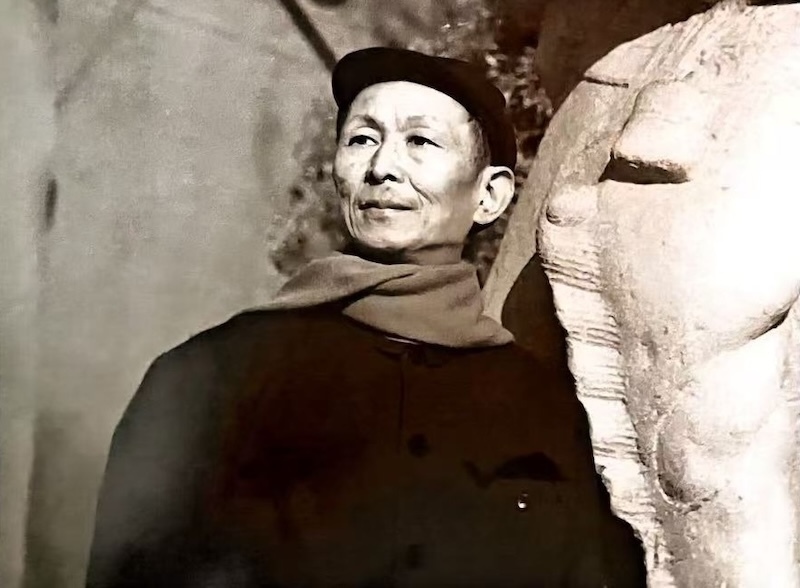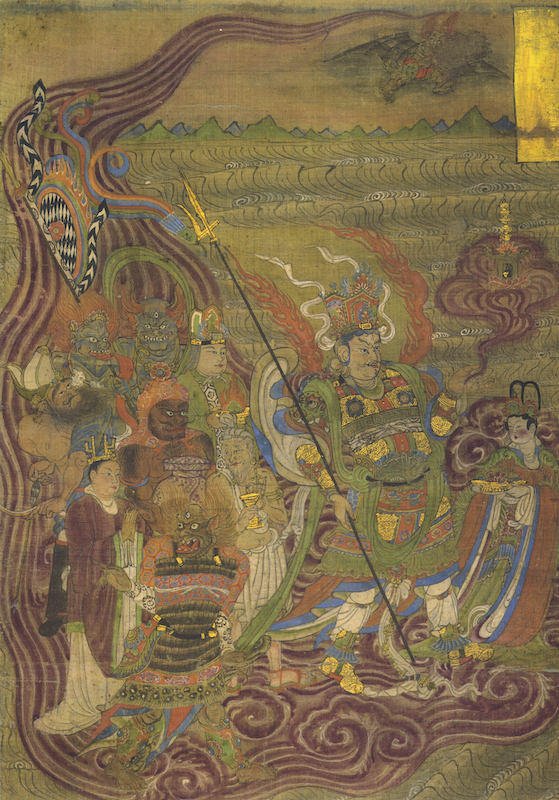

On September 20, the "What Makes Dunhuang" Dunhuang Art Exhibition officially opened at the China Art Palace (Shanghai Art Museum). This exhibition showcases the most comprehensive and diverse collection of Dunhuang cultural and artistic artifacts ever presented in Shanghai, featuring "cultural relics + replicas of classic caves + wall paintings and sculptures."
The exhibition features 168 representative and extremely rare precious artifacts on loan from the Dunhuang Academy, including some of the largest and most significant pieces in their collection, such as the "Beiliang Stone Pagoda," the selected national treasure "Guoyi Army Official's Wine Receipt," and the "Shengli Stele," which documents the timeline of the Mogao Grottoes. Notably, artifacts like the northern Wei embroidered Buddha image from the museum are being displayed for the first time in Shanghai.

Exhibition Scene
The Silk Road stretches for thousands of miles, resembling a jade belt that winds between desert and oasis. Dunhuang is a gem along this long route, with marks of a civilization that has thrived for thousands of years.
Upon entering the exhibition hall, the stone-yellow hues transport visitors instantly into the vast Gobi Desert, where the sound of distant camel bells seems to echo, brimming with infinite imagination. The first section of the exhibition, "Silk Road · Dunhuang," begins with the great Zhang Qian carving out the western regions and the interchange of goods between merchants from various countries, where the convergence of diverse cultures allowed the Dunhuang flower to blossom, and made the ancient Yangguan and Yumenguan resonate through history.
The second section, "Caves · Pure Land," serves as the centerpiece of this grand exhibition. It features 1:1 replicas of six classic caves from Dunhuang: Cave 285 from the Western Wei, Cave 45 from the High Tang, Cave 320 from the High Tang, Cave 158 from the Middle Tang, Cave 17 from the Late Tang, and Cave 3 from the Yuan Dynasty.

Replica of Cave 45, Exhibition Scene
Former Dunhuang Academy president Duan Wenjie referred to Cave 285 from the Western Wei as the "Pantheon," as it features a rich array of content that includes Buddha figures, bodhisattvas, heavenly beings, and warriors, along with deities from both Eastern and Western mythology such as Fuxi, Nuwa, Thunder God, Rain God, Brahman deities, and the Sun and Moon gods from the West. Located on the second level of the Mogao Grottoes, its main chamber has a dome-shaped ceiling, with a large niche in the center of the west wall housing a seated Buddha, flanked by smaller niches with Zen monk statues, and four Zen caves on the left and right walls. The cave is well-preserved and features inscriptions indicating its creation during the fourth and fifth years of the Western Wei Daotong period (538-539 AD), making it the earliest dated cave at Mogao.

Exhibition Scene, Cave 285
Cave 45 is known as the "Hall of Exquisite Statues" and is located on the lower section of the middle southern area of the Mogao Grottoes. The statues in the main niche echo masterpieces of Tang-era sculptural artistry. As one of the representative caves of the peak Tang period, its lifelike statues and intricately detailed wall paintings reflect the lifestyles of various social classes during the flourishing Tang dynasty, leaving a deep impression on viewers.

Exhibition Scene, Cave 45

Replica of Cave 320 from the High Tang, Exhibition Scene
Cave 320 from the High Tang, acclaimed by Chang Shuhong as the "Most Beautiful Flying Deity," was built during the late High Tang period. Its main chamber sports a dome-shaped ceiling, and the large niche on the west wall houses a Buddha, a disciple, and two bodhisattvas; the niche ceiling is adorned with a Buddha sermon depicted in a picturesque manner, with floral patterns along the rim of the niche and wall paintings of sacrificial vessels on the base layer, revealing images of the offering patrons and lions from the Song dynasty.

Flying Deities on the Southern Wall of Cave 320, Amitabha Buddha Sermon Picture
The flying deities in the upper part of the Amitabha Buddha sermon picture on the southern wall show a dynamic arrangement, with four flying deities split into two lines; the front two are symmetrically positioned to guard either side of a floral canopy, one hand scattering flowers while the other gestures to welcome, their graceful figures and flowing ribbons seemingly animated by movement. The two flying deities in the back follow suit, also in postures of scattering flowers and inviting, with long ribbons accentuating their light and lively flight. This entire scene, composed of flying deities and flowing clouds in a vibrant color palette, vividly represents the majestic realms of Western paradise and stands as one of the most emblematic works of Tang style flying deities from Mogao.

The "Most Beautiful Nirvana Buddha" from Cave 158 of the Middle Tang, Exhibition Scene

The "Most Beautiful Nirvana Buddha" from Cave 158 of the Middle Tang, Exhibition Scene
The centerpiece of the exhibition is the "Most Beautiful Nirvana Buddha" from Cave 158 of the Middle Tang, a notable Nirvana cave at Mogao. This cave is rectangular in shape, housing a stone-cast mud sculpture of the Nirvana Buddha that measures 15.80 meters in length, reclining serenely to the right, with a serene expression and a hint of a smile, portraying the tranquil scene of "finding joy in nirvana." Complementing this Nirvana statue, the wall paintings on the southern, western, and northern walls depict weeping disciples and worldly figures mourning over the Buddha’s parinirvana.

Exhibition Scene, Cave 17 from the Late Tang
Cave 17 from the Late Tang serves as a key to unlock the history of the medieval world. This cave was originally the meditation hall of the late Tang monk Hong Bian, the overall coordinator of the Buddhist clergy in Hexi. In 1900, thousands of ancient manuscripts and cultural artifacts in various languages, including Han, Tibetan, Uighur, Sogdian, Sanskrit, Khotanese, and Tocharian, were discovered in the Mogao Caves (currently Cave 17). This discovery provided an extraordinarily vast and rich array of information for studying the ancient histories, geography, religions, economies, politics, ethnicities, languages, literature, arts, and sciences of China, Central Asia, West Asia, and Europe, earning it the title of "a key to unlocking the history of the Silk Road," sparking a global craze for "Dunhuang Studies."

Thousand-Handed, Thousand-Eyed Guanyin Wall Painting in Cave 3 from the Yuan Dynasty
Cave 3 from the Yuan Dynasty is the only cave dedicated to Guanyin among the existing Dunhuang caves. Both the left (south wall) and right (north wall) depict the Thousand-Handed, Thousand-Eyed Guanyin, each featuring a frontal view as the main focus, flanked by side profiles. The images are outlined with a fine ink touch, exhibiting elegant colors and a dignified, restrained form; particularly praiseworthy is the richness and colorfulness of the line drawings, as the garments resemble orchid leaves and folded reeds. The figures' expressions and postures are illustrated with strong, robust lines... The wall paintings in Cave 3 mark the high development of Yuan painting art and stand as a remarkable statement of the late stone grotto art at Mogao. Hence, the artistic creation of Mogao Caves comes to an end.

The Beiliang Stone Pagoda
According to information from Pengpai News, this exhibition includes a total of 168 artifacts from the collection of the Dunhuang Academy, among which six heavyweight national treasure artifacts are debuting in Shanghai.
The largest piece in the Dunhuang Academy's collection is the "Beiliang Stone Pagoda," a Class A national cultural relic and one of the earliest Buddhist stone pagodas in China. The pagoda’s top is missing, surrounded by eight niches adorned with reliefs of seven seated Buddhas and one Maitreya in a seated position. The cylindrical body of the pagoda is inscribed with the Han text from the “Zeng Yi A Han Jing - Jie Jin Pin” and the Brahmi text from the “Yuan Qi Jing,” with eleven lines remaining. Its structure, patterns, and inscriptions exhibit a fusion of Eastern and Western elements, serving as a testament to the transmission of Buddhism to China and its gradual localization within Chinese culture.

The Six-Character Mantra Stele from Mogao
The "Six-Character Mantra Stele from Mogao" bears witness to the long history of coexistence, inclusiveness, and mutual learning among multiple ethnic cultures along the Silk Road. This stele, a famous inscription from the Yuan Dynasty, features "Mogao Cave" inscribed in relief at the top, with a statue of the four-armed Guanyin carved in the center surrounded by the "six-character mantra" depicted in six different languages: Sanskrit, Tibetan, Han, Tangut, Mongolian, and Phags


